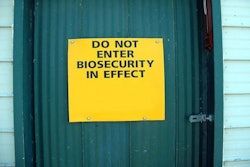
Leading observers of the avian influenza outbreak in the United States agree the disease will remain present in the country for the foreseeable future.
“We continue to get detections even in December (2022),” Dr. Julianna Lenoch, the National Wildlife Disease Program Coordinator at U.S. Department of Agriculture’s (USDA) Animal Plant & Health Inspection Service (APHIS) said. “We're almost a year in on this outbreak and I don't see the risk subsiding.”
Avian influenza’s toll
Since its first detection in Canada in December 2021 and in January 2022 in the U.S., the virus continues to move around North America with great impact on commercial poultry operations.
In 2022, the turkey industry was harshly affected by depopulation driven by the disease. In September 2022, the USDA projected overall turkey production would fall by 2% compared with the prior year largely due to millions of depopulations.
The disease continues to inject uncertainty into agricultural markets and the poultry industry. Consumers are likely paying a higher price on turkey and eggs due to the virus, too.
The disease is also significant to the export market. In the past, countries used the disease as a reason to block U.S. poultry imports. Lenoch said the H5N1 disease is a global issue, which is a significant reason why its still present in domestic wild bird populations.
Wild birds
A key vector for this outbreak, as opposed to the 2014-2015 occurrence, is the HPAI virus did not die out in wild bird populations, said Bryan Richards, emerging disease coordinator at the U.S. Geological Survey’s National Wildlife Health Center.
The 2022 outbreak was expected to taper off in the warmer months of the year. Influenzas are common in wild birds and they can carry them without symptoms. Typically, low pathogenic avian influenzas outcompete the HPAIs, but it didn’t this time, Richards said. Lenoch said the temperature didn’t play a factor with this virus, either.
Dr. Richard Webby, director of the World Health Organization’s Collaborating Centre for Studies on the Ecology of Influenza in Animals and Birds, said the HPAI virus is highly fit for wild birds and lacks any specific immunity in their populations
“High transmission combined with low immunity is a recipe for continued outbreaks,” Webby said. “Right now, there are just so many infected birds, the amount of virus around is staggering.”
In 2022, Richards said there is notably more wild bird transmission than in the prior decade. The prior outbreak featured many farm-to-farm viral transitions caused by human activity. This one points to more than 85% of individual outbreaks at commercial facilities originating with wild birds shedding the virus near the facility.
Richards said common, wild North American birds like the migrating mallard, or the far-ranging black vulture, are exceptionally good at carrying and spreading the disease. Vultures may even play an outsized role in keeping the global outbreak active in their colonies, he said.

Endemic?
The word endemic is highly charged in the situation surrounding avian influenza.
Lenoch said the USDA APHIS does not use the term endemic referring to avian influenza since wild birds naturally carry influenzas. Officially, endemic would be applied to a foreign animal disease and then mostly to farmed animals in an agricultural sector.
“We understand and appreciate right now that wild birds are carrying a heavy load of (HPAI),” Lenoch said.
Webby said the future of H5N1 remains unknown, but he feels like the disease is headed toward endemicity among the North American wild bird population due to the large number of birds and bird species involved.
Richards wasn’t sure about endemic status either since the word carries so many qualifications. Viruses are constantly evolving and this H5N1 is no exception. However, he said some in Europe are considering what the consequences would be of declaring endemicity – or vaccinating their commercial birds – due to the long-term challenges the continent is facing with the disease.
Looking ahead
HPAI could be just another part of life for the North American poultry industry going forward. Current trends indicate it will persist for now, at least.
Richards and Lenoch pointed to federal readiness programs drafted in response to the 2014-2015 HPAI outbreak. Both public health officials and the industry learned much from then and they continue to teach and preach strong biosecurity in response to the virus threat.
Lenoch also said the U.S. spent the past two years preparing for another outbreak due to the persistent situation in Europe.
Vaccination
Further down the road, vaccination could be a tool to control avian influenza. However, vaccination carries potential negative consequences to export markets. The U.S. consistently exports chicken around the world and needs the markets.
Richards said some in Europe are already considering vaccination. Since the virus is present and export markets are already going away or lost, he said, vaccination against HPAI could be a way to defeat the virus.
Lenoch said, along with the trade implications, vaccination would be a challenge, carrying high costs and requiring extensive coordination and surveillance to manage in the U.S.
“It is something that would need to be carefully planned and executed to help ensure it will truly bring benefits,” said Lenoch.
Webby said producers in the U.S. must consider vaccination as a possibility.
“We need to explore every avenue we have for control and management of the virus,” Webby said. “This includes the current operations, changes to management, and also vaccination.”
“If this virus does indeed become endemic then we need to very seriously consider it. Maybe it won’t be ideal for all populations, but some could certainly benefit.”
Will avian influenza reach Brazil? WATTAgNet.com/articles/46332
















